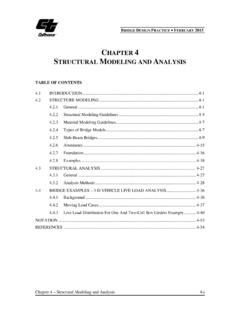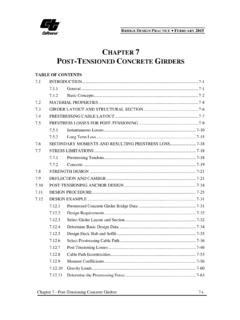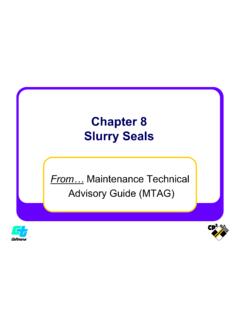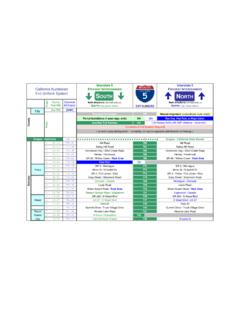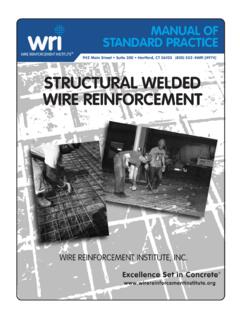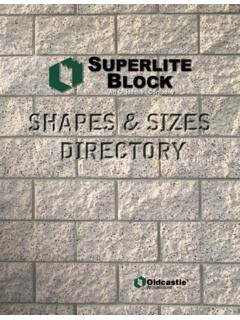Transcription of METHOD OF TEST FOR RELATIVE COMPACTION OF …
1 1 California Test 216 June 2011 STATE OF CALIFORNIA BUSINESS, TRANSPORTATION AND HOUSING AGENCY DEPARTMENT OF TRANSPORTATIONDIVISION OF ENGINEERING SERVICES Transportation Laboratory 5900 Folsom Blvd. Sacramento, California 95819-4612 METHOD OF TEST FOR RELATIVE COMPACTION OF UNTREATED AND TREATED SOILS AND AGGREGATESA. SCOPE This test METHOD describes the procedure used to determine the RELATIVE COMPACTION of untreated and treated soils and aggregates. RELATIVE COMPACTION in this METHOD is defined as the ratio of the in-place, wet density of a soil or aggregate to the test maximum wet density of the same soil or aggregate when compacted by a specific test METHOD . The procedures are presented in 2 parts: Part 1.
2 Determine the in-place, wet densityPart 2. Determine the laboratory test maximum wet density and percent RELATIVE COMPACTION California Test 110 Calibration of COMPACTION Test Equipment California Test 226 Moisture Content of Soils and Aggregates by Oven Drying California Test 231 RELATIVE COMPACTION of Untreated and Treated Soils and Aggregates Using Nuclear GaugesCalifornia Test 312 Designing and Testing Classes "A" and "B" Cement Treated BasesAASHTO T 191 Density of Soil In-Place by the Sand-Cone METHOD ASTM D 1556 Density and unit weight of Soil in Place by Sand-Cone METHOD PART , WET DENSITY The principal use of the in-place, wet density value is in the RELATIVE COMPACTION control of earthwork construction.
3 However, the identical procedure and apparatus are also employed to obtain data for volume-to- weight conversion factors and shrinkage or swell factors. PROCEDURE The determination of the in-place wet density requires excavating and weighing a sample of soil from the area under investigation, measuring the volume of the sample excavation by back- filling with calibrated test sand, and calculating the unit wet weight of the excavated sample. Perform this test in accordance with AASHTO T 191. NOTE: Typically, the test hole excavation alone will not provide a sufficient volume of material required for completion of Part 2 of this test METHOD . Therefore, it is necessary to obtain a bulk sample of soil immediately adjacent to the excavated test hole following the completion of the sand volume Test 216 June 2011 2 OF RESULTS The block headed Sand Volume Data on the RELATIVE COMPACTION Test Worksheet (Form TL-297 attached) provides for the data accumulated at the in-place test hole site.
4 PART COMPACTED TEST MA XIMUM WET DENSITY AND PERCENT RELATIVE COMPACTION standard California impact COMPACTION test apparatus consisting of a split cylindrical mold, a lb tamper, a metal piston, and a piston-handling rod, as illustrated in Figure 1. (See California Test 110 for calibration.) concrete base block, or an equally rigid body, approximately 1 cu ft in size. : a balance or scale of at least 3 kg capacity and sensitive to 1 g. PROCEDURE A bulk sample of soil is divided into smaller portions. These portions are prepared with varying moisture contents to form test specimens, which are individually compacted by a uniform compactive effort, to determine the test maximum density for the particular soil under consideration.
5 NOTE: The test maximum density determination and percent RELATIVE COMPACTION for Class A Cement Treated Base (CTB) is determined in accordance with California Test 312. SAMPLE Obtain a bulk sample of soil, 35 lb minimum in we ight, at the site of the in-place density test hole. It is essential that the bulk sample be preserved at the same moisture as prevailed at the time of excavation for the duration of the test. Use only moisture-proof containers and protect from high temperatures. OF TEST SPECIMENS 1. Separate the bulk sample on the in. sieve, weigh both the retained and passing fractions, and compute the percentage retained in terms of wet weight of the total bulk sample.
6 If 10 % or more of the total weight is retained on in. sieve, follow the test procedure set forth in Section 2I. If the retained in. fraction comprises less than 10 % by weight of the total bulk sample, discard it and divide the passing in. fraction into representative 5 test specimens of equal weight (within 1 g), each sufficient in amount to form a compacted test specimen of 10 to 12 in. in height when compacted as specified in Section 2E. NOTE: Sufficient samples should be prepared to satisfy the conditions of While these conditions are often met with 3 samples, it is prudent to separate 5 samples at this stage. 2. It is of the utmost importance that all of the bulk sample material be thoroughly mixed.
7 Each test specimen must be representative of the soil or aggregate mass, be of equal weight , be weighed in immediate succession, and be placed at once in the 1 gal moisture-sealed individual Test 216 June 2011 3 3. The correct weight for each test specimen will depend on the soil type and the moisture content. 2200 to 2700 grams wet weight is the usual range of weight . 4. Record the initial weight of the individual test specimens on Line I of Form TL-297. 2E. COMPACTION OF TEST SPECIMENS 1. Divide 1 of the test specimens prepared as outlined in Section 2D into 5 approximately equal portions by either weight or volume measurement and store in separate gal moisture-sealed containers.
8 Place 1 portion in the test mold and compact it with 20 blows of the tamper dropping free from a height of 18 in. above the surface of the material in the mold. Repeat this operation for each of the remaining 4 portions. After the COMPACTION of the fifth portion, place the ,piston in the mold and level the top of the compacted specimen with 5 blows of the tamper dropping free from a height of 18 inches above the surface of the piston. 2. With the tamper foot resting on the piston atop the compacted test specimen, read the graduated tamper shaft to the nearest graduation at a point level with the top of the mold. Enter this value on Line J of Form TL-297. NOTE: If a graduation is not level with the top of the mold, read the next highest graduation , the first graduation just below the top of the mold.
9 3. Obtain the adjusted wet density in grams per cubic centimeter from Table 1 corresponding to the tamper shaft graduation reading using the column corresponding to the initial wet weight of test specimen (Line I) and record it on line K of Form TL-297. 4. Save the specimen temporarily for possible later use. (See the first paragraph of Section 2G.) 5. Adjust the moisture contents of the remaining test specimens to satisfy the following conditions: a. The object is to have at least 1 test specimen with moisture content below test optimum, 1 close to optimum and 1 above optimum, at about 2 % moisture content increments, with a minimum of 3 test specimens. While the actual moisture contents will not be known, the moisture content of the test specimen with the highest adjusted wet density is the test optimum moisture content even though the moisture content is unknown.
10 Therefore, the primary objective is to have a number of test specimens and a range of moisture contents such that at least 1 specimen will be compacted at a moisture content less than, and 1 at a moisture content greater than, the moisture content of the specimen having the highest adjusted wet density. If this condition cannot be satisfied with the minimum 3 test specimens it will be necessary to fabricate additional specimens. NOTE: With some material, aggregate base for example, it may be necessary to increase or decrease moisture increments. Once the initial increment has been determined ( , 1 %, %, 2 %), it should be constant throughout the test. California Test 216 June 2011 4 NOTE: The first test specimen is generally compacted at the moisture content present in the bulk sample.
